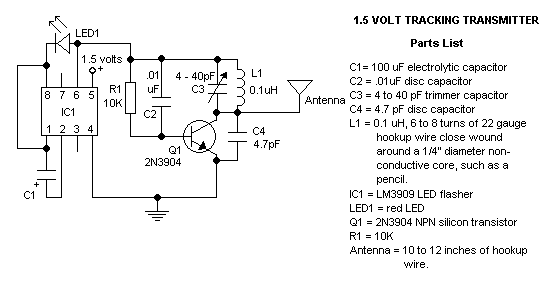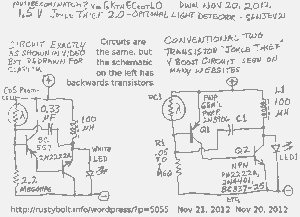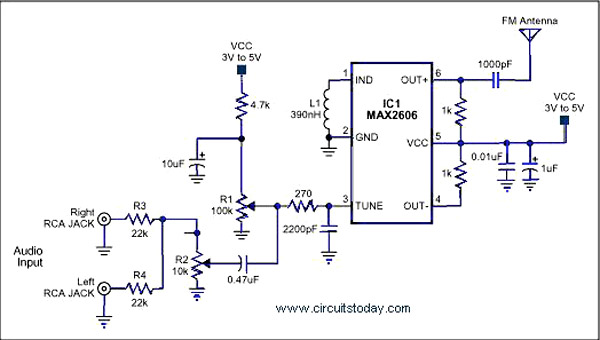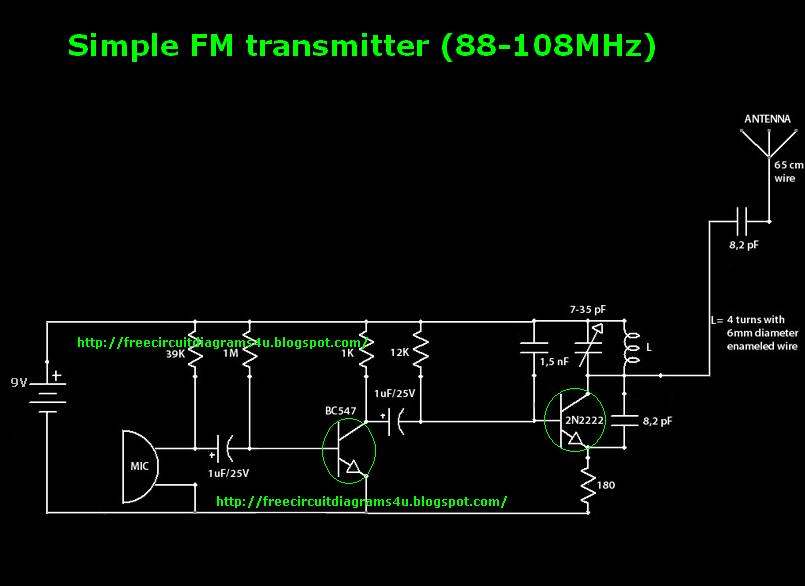
1.5v tracking transmitter

The circuit is a common form used in FM transmitters. The transistor conducts for 60-90 electrical degrees. When it turns off the LC tank rings, completing the sinusoidal waveform coupled to the antenna. The circuit is 77-85% efficient, compared to 40-50% for a linear oscillator.
The described circuit utilizes a transistor-based oscillator configuration, commonly employed in FM transmitter applications. The operation of this circuit hinges on the interaction between the transistor and an LC tank circuit, which consists of an inductor (L) and a capacitor (C) connected in parallel or series. This arrangement is crucial for generating the oscillatory signal required for frequency modulation.
During the conduction phase, which lasts for approximately 60-90 electrical degrees of the input signal, the transistor allows current to flow through the LC tank circuit. This current flow energizes the inductor and capacitor, resulting in the storage of energy within the tank circuit. When the transistor turns off, the stored energy in the inductor and capacitor causes the circuit to oscillate, producing a sinusoidal waveform. This oscillation is critical for generating the carrier wave necessary for FM transmission.
The efficiency of this circuit, reported to be between 77-85%, is significantly higher than that of linear oscillators, which typically achieve efficiencies of only 40-50%. This higher efficiency is attributed to the switching nature of the transistor operation, which minimizes power loss during the conduction and cutoff phases.
The output of the oscillator is coupled to an antenna, allowing the generated RF signal to be transmitted over the air. The quality of the output waveform is essential for effective transmission, as it influences the modulation characteristics and overall performance of the FM transmitter. Proper tuning of the LC tank circuit is necessary to ensure that the oscillator operates at the desired frequency, providing optimal transmission characteristics.
In summary, this circuit exemplifies an efficient method for generating FM signals, leveraging the properties of a transistor and an LC tank circuit to produce a robust and effective transmission output.The circuit is a common form used in FM transmitters. The transistor conducts for 60-90 electrical degrees. When it turns off the LC tank `rings`, completing the sinusoidal waveform coupled to the antenna. The circuit is 77-85% effecient, compared to 40-50% for a linear oscillator. 🔗 External reference
The described circuit utilizes a transistor-based oscillator configuration, commonly employed in FM transmitter applications. The operation of this circuit hinges on the interaction between the transistor and an LC tank circuit, which consists of an inductor (L) and a capacitor (C) connected in parallel or series. This arrangement is crucial for generating the oscillatory signal required for frequency modulation.
During the conduction phase, which lasts for approximately 60-90 electrical degrees of the input signal, the transistor allows current to flow through the LC tank circuit. This current flow energizes the inductor and capacitor, resulting in the storage of energy within the tank circuit. When the transistor turns off, the stored energy in the inductor and capacitor causes the circuit to oscillate, producing a sinusoidal waveform. This oscillation is critical for generating the carrier wave necessary for FM transmission.
The efficiency of this circuit, reported to be between 77-85%, is significantly higher than that of linear oscillators, which typically achieve efficiencies of only 40-50%. This higher efficiency is attributed to the switching nature of the transistor operation, which minimizes power loss during the conduction and cutoff phases.
The output of the oscillator is coupled to an antenna, allowing the generated RF signal to be transmitted over the air. The quality of the output waveform is essential for effective transmission, as it influences the modulation characteristics and overall performance of the FM transmitter. Proper tuning of the LC tank circuit is necessary to ensure that the oscillator operates at the desired frequency, providing optimal transmission characteristics.
In summary, this circuit exemplifies an efficient method for generating FM signals, leveraging the properties of a transistor and an LC tank circuit to produce a robust and effective transmission output.The circuit is a common form used in FM transmitters. The transistor conducts for 60-90 electrical degrees. When it turns off the LC tank `rings`, completing the sinusoidal waveform coupled to the antenna. The circuit is 77-85% effecient, compared to 40-50% for a linear oscillator. 🔗 External reference




